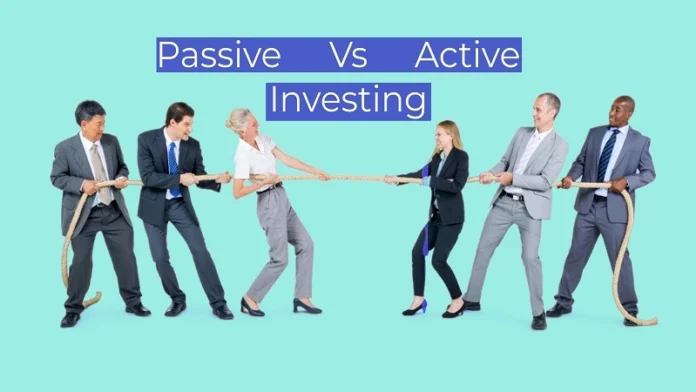Table of Contents
You might have heard about active and passive investing but don’t have a clear understanding of this. It’s easy to know the difference between passive and active investing.
Passive investing rarely involves buying and selling stocks. It’s about capturing the overall market returns with lower costs and lower stress. In contrast, active investing is the opposite it involves regularly buying and selling stocks if necessary. This approach requires research, analysis, and a keen eye on market trends. In active investing returns are higher but risks and costs are also potentially higher compared to passive investing.
Come with us and learn about passive vs active investing! Let’s begin with it!
What is Passive Investing?
Passive investing is long-term investing. It involves restricting the buying and selling of stocks within one’s portfolio, making it cost-effective.
Moreover, the primary aim of passive investing is to create wealth. It is also popularly known as a buy-and-hold method, which means buying funds or stocks and resisting them to anticipate the next move in the stock market (buying the security for the long term).
What is Active Investing?
Active investing generally implies a hands-on approach. It wants someone to behave as a portfolio manager, whether maintaining their own portfolio or professionally managing different ones.
Additionally, active investing primarily aims to beat the stock market’s average returns and take advantage of short-term investment price increases and decreases. Active investing must examine an investment for any price returns and changes (if any).
Passive Investing vs Active Investing
The debate on passive vs active investing is gaining much attention as investors weigh the pros & cons of each strategy in pursuit of gaining higher returns. Let’s have an overview of the passive vs active investing approach:
Pros and Cons of Passive Investing
| Pros | Cons |
| Consistent Returns | Smaller Returns |
| Lower Costs | Too Many Restrictions |
| Lower Risks | Less Flexibility |
| Transparency | Less Potential for Outperformance |
| Tax Efficiency | Susceptibility to Market Fluctuations |
Pros of Passive Investing
Managing a diversified portfolio is vital in successful investing, and passive investing allows investors to achieve that diversification, which has various pros and cons. Let’s look into those:
1. Consistent Returns
Passive investing aims to analyze a market index’s performance and offer consistent returns that closely track the index.
2. Lower Costs
Passive investing has a low expense ratio because of the straightforward investment strategy and limited fund manager’s role.
3. Lower Risks
They mitigate some risks connected with stock-picking & portfolio manager selection.
4. Transparency
It always specifies which assets are there in the index fund.
5. Tax Efficiency
The buy-and-hold passive investing strategy only results in a small capital gains tax for one year.
Cons of Passive Investing
1. Smaller Returns
Passive investments could not beat the market because their stocks were locked to track it.
2. Too Many Restrictions
These investments are restricted to a predetermined set of investments or specific indices with less or no variance.
3. Less Flexibility
Don’t refrain from adapting to the changing market trends or capitalize on various investment opportunities.
4. Less Potential for Outperformance
These funds may produce less market returns in specific market conditions.
5. Susceptibility to Market Fluctuations
These investments are at higher market risks because their performance is connected to the underlying index.
Pros and Cons of Active Investing
| Pros | Cons |
| Flexibility and Adaptability | Huge Risks |
| Research and Expertise | Too Expensive |
| Higher Returns | More Prone to Human Error |
| More Flexibility | Bad Track Record |
| Tax Management | |
| Hedging |
Pros of Active Investing
In contrast to passive investing, active investing has pros and cons. Let’s consider the following:
1. Flexibility and Adaptability
Active investing managers can adapt to changes in market trends and capitalize on investment opportunities, offering the potential to capture profits or mitigate risks.
2. Research and Expertise
Actively managed investments are backed by great analysis and research conducted by experts.
3. Higher Returns
The primary aim of active investing is to outshine the benchmark index with the help of experts and fund managers, leading to higher returns.
4. More Flexibility
Active investors didn’t need to follow a particular index. They can buy stocks of their choice.
5. Tax Management
Advisors can prepare tax management strategies for investors.
6. Hedging
Active managers can restrict their bets with several techniques like put options or short sales.
Cons of Active Investing
1. Huge Risks
Managers are liberal enough to purchase any investment they think would give huge returns, which is false.
2. Too Expensive
Fees are higher due to the trigger of active selling & buying transaction costs.
3. More Prone to Human Error
Decision-making is a significant human error that can introduce losses and risks.
4. Bad Track Record
Active investing portfolios can beat passive benchmarks, specifically after fees and taxes.
What is the Key Difference Between Passive and Active Investing?
Let’s explore the key differences between passive and active investing. This will help you understand the key differences in a better way.
1. Expense Ratio
Expense ratios reflect the costs associated with fund management and differ between passive and active investing. The expense ratio is lower for passive investing because it requires fewer transaction costs and less active management.
On the contrary, the expense ratio for active investing is higher because it doesn’t charge transaction costs. Lower expense ratios can convert to huge net returns for passive investors.
2. Risk
The risks linked to passive vs active investing also differ. Active investing may put investors at higher risk, as fund managers’ decisions are subject to human error, and pursuing huge returns generally brings on additional risk.
On the contrary, passive investing mitigates the risks by following a predetermined index, eradicating portfolio managers and stock-picking risks with the help of rule-based investing.
3. Returns
Speaking of passive vs active investing in terms of returns, the prime aim of active investing is to outshine its benchmark and deliver huge returns by using the expertise of fund managers and decision-making.
On the other hand, passive investing keeps a keen eye on the benchmark index, offering investors huge returns. While they might not produce significant alpha or higher returns that mirror the index performance, they deliver huge returns.
4. Nature
The nature of passive investing vs active investing varies in the investment approach. Passive investing tracks a market index. In contrast, active investing includes active stock-picking to outshine the market.
Active investing requires hands-on involvement from fund managers, who buy and sell securities. Unlike passive investing, active investing requires less involvement from the fund managers.
Passive Investing vs Active Investing: Which is Better?
The choice between passive and active investing can vary depending on the investment method chosen.
Passive management excellently works for traded holdings such as stocks in large U.S. corporations, as per the speaking of “Smetters” – “you should never pay for active management for those things.”
However, in specific niche markets, such as small company stocks and emerging markets, where only some people are watching and assets are less liquid, it is feasible for an active manager to identify diamonds in the rough.
When differentiating passive vs active investing, one should consider the pros and cons, investment goals, risk tolerance, and time to manage the investment. Both strategies have some benefits, and a well-balanced investment strategy could be a mix of passive and active funds for optimal diversification.
Investors looking for higher returns and want to take additional risks may choose active investing. They can benefit from the fund manager’s expertise, who looks for various investment opportunities and adjusts the portfolio according to market conditions.
Hope this differentiation of passive vs active investing will help you choose the best fit with your financial goal.
Closing Words
Both passive and active investing strategies have a unique place in the market, but each strategy attracts different investors. The difference between passive and active investing can be seen in the pros and cons of investors deciding which one to choose.
Passive investment can be a lucrative option for investors who want huge returns with fewer risk factors over a longer time. Otherwise, go with the active investing strategy if you don’t want to avoid playing safe.
Also, you might want to learn more about How to Build and Save for Emergency Funds.



